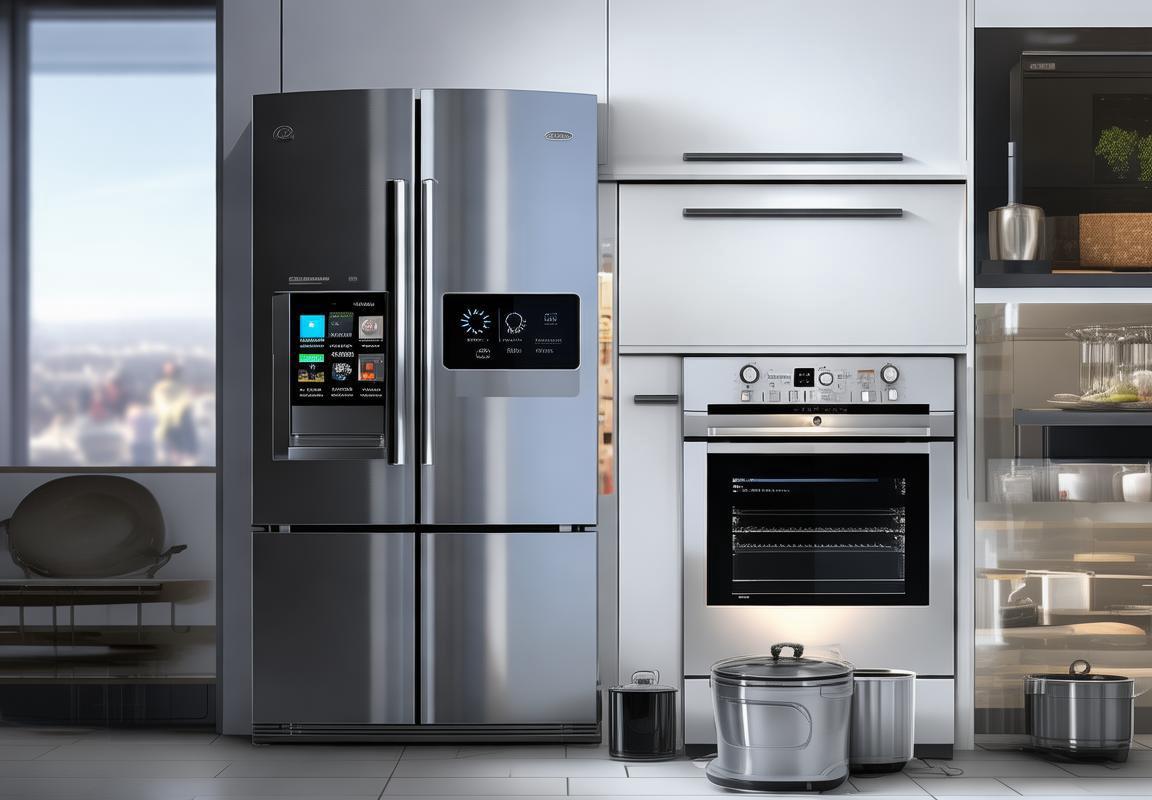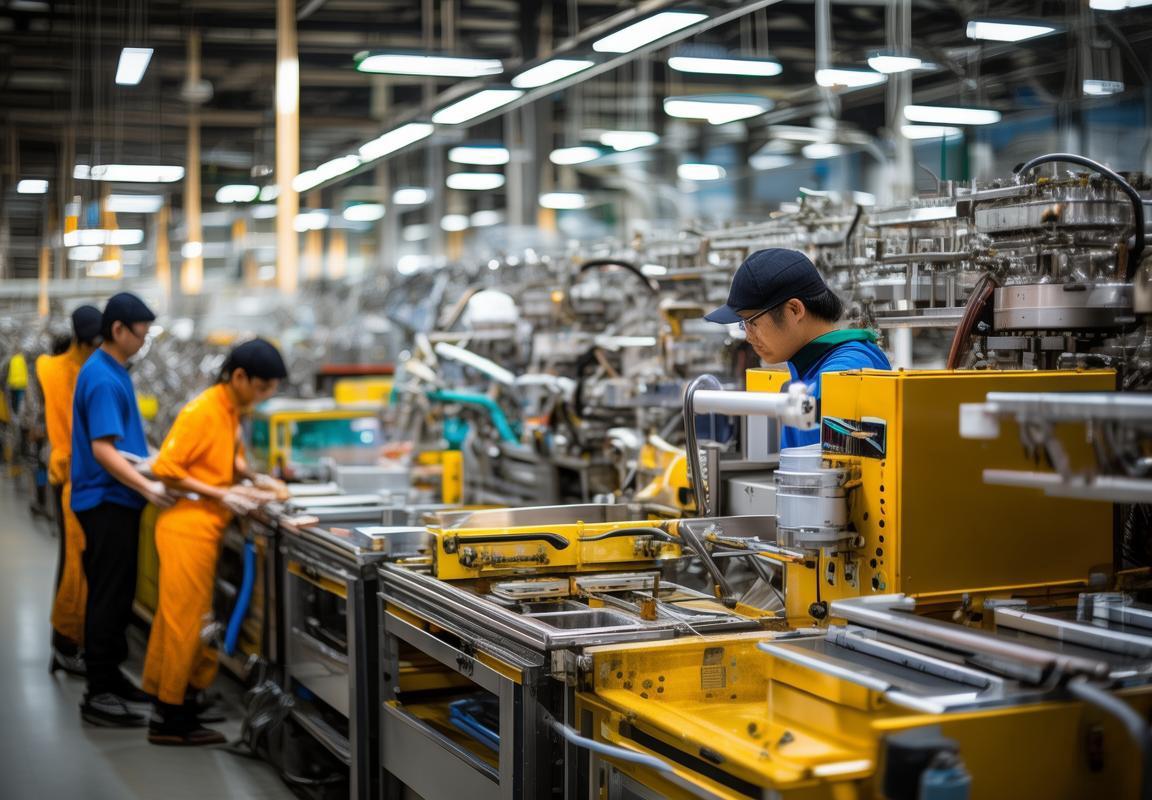In the ever-evolving landscape of kitchen appliances, the dynamics between local suppliers and the global market are reshaping the industry. As import substitution programs gain traction, the stage is set for a new era of growth and innovation. This shift presents a unique opportunity for domestic manufacturers to capitalize on local demand while navigating the complexities of a changing market. By understanding the consumer trends and the challenges that lie ahead, suppliers can position themselves for success in the years to come. Let’s delve into the intricacies of these trends and the strategies that will define the future of the kitchen appliances market.
1 Understanding Import Substitution Programs
Import substitution programs are a strategic approach that nations adopt to reduce their dependence on imported goods and foster the growth of domestic industries. At their core, these programs aim to substitute foreign products with locally produced alternatives, thereby stimulating the local economy and ensuring national self-sufficiency. When it comes to the kitchen appliances market, understanding how import substitution programs work is crucial for suppliers, manufacturers, and consumers alike.
The concept of import substitution is rooted in the desire to protect domestic industries from foreign competition. By imposing tariffs, quotas, or other trade barriers, countries can create a more favorable environment for local producers. This not only helps in preserving jobs within the country but also supports the development of technology and innovation that can eventually lead to the creation of competitive products.
In the context of kitchen appliances, import substitution programs can take several forms:
-
Tariffs and Duties: Governments may impose higher tariffs on imported appliances, making them more expensive compared to locally produced ones. This can encourage consumers to opt for domestic products, as they become more cost-competitive.
-
Quotas: Limits on the quantity of imported appliances can be set, ensuring that a certain percentage of the market is reserved for domestic suppliers. This can help in stabilizing the market and providing a consistent demand for local manufacturers.
-
Subsidies: Financial incentives may be offered to domestic producers to help them lower costs and improve the quality of their products. This can make local appliances more attractive to consumers.
-
Regulatory Requirements: Stringent regulations can be enforced on imported appliances, requiring them to meet certain standards that domestic products may not need to adhere to. This can indirectly support domestic manufacturers.
-
Promotion and Awareness Campaigns: Governments may run campaigns to educate consumers about the benefits of purchasing locally made appliances. This can include highlighting the quality, durability, and support provided by domestic suppliers.
The rationale behind these programs is clear: by promoting domestic production, countries can reduce their trade deficits, enhance their national security, and ensure a steady supply of essential goods. However, the execution and impact of import substitution programs can vary widely.
For kitchen appliances, the implications are significant:
-
Local Suppliers Gain: Domestic suppliers benefit directly from import substitution programs. They see an increase in demand for their products, which can lead to expanded production capacity and improved profitability.
-
Innovation and Quality: To compete with foreign brands, local manufacturers often need to innovate and improve the quality of their appliances. This can lead to the development of new technologies and better products over time.
-
Consumer Choices: Consumers may find a wider range of locally produced appliances available to them, which can include unique designs and features that cater to local preferences.
-
Long-term Challenges: Despite the benefits, import substitution programs can also pose long-term challenges. Local manufacturers may struggle to keep up with global technological advancements and may become complacent without the pressure of international competition.
-
Economic Impact: The success of import substitution programs can have a ripple effect on the broader economy. Increased domestic production can lead to job creation, higher incomes, and a more robust industrial base.
In summary, import substitution programs in the kitchen appliances market are a complex web of policies and economic strategies. They can provide a significant boost to local suppliers and manufacturers, but they also require careful management to ensure that they do not stifle innovation or lead to inefficiencies. As the global landscape continues to evolve, the effectiveness of these programs will depend on the ability of domestic industries to adapt and thrive in a competitive environment.

The European and North American Kitchen Appliances Markets
The European kitchen appliances market is a testament to the blend of tradition and innovation, reflecting the diverse cultures and high standards of living across the continent. From the sleek, minimalist designs of Scandinavian countries to the robust, functional appliances in Italy and Germany, there’s a clear emphasis on quality and durability. Smart kitchen technology is also gaining traction, with a growing number of consumers opting for integrated systems that offer convenience and efficiency. The market is segmented into various categories, including refrigerators, dishwashers, ovens, and small appliances, each with its own set of trends and preferences.
In North America, the kitchen appliances market is characterized by its vast size and the varied tastes of its consumers. The United States and Canada dominate the region, with a preference for larger, more powerful appliances that cater to both the professional chef and the home cook. The market is marked by a strong focus on energy efficiency, with consumers increasingly looking for appliances that are both eco-friendly and cost-effective. Brands like KitchenAid, GE, and Whirlpool have established a strong presence, offering a wide range of products that cater to different budgets and lifestyles.
In Europe, the market is witnessing a shift towards energy-saving and sustainable appliances. The European Union’s stringent energy efficiency standards, such as the Energy Label, have become a benchmark for manufacturers. The market is also influenced by the rise of health-conscious consumers, who are looking for appliances that can help them prepare nutritious meals. This has led to an increase in demand for multi-functional appliances, such as induction cooktops and steam ovens, which offer a variety of cooking options with minimal energy use.
North American consumers, on the other hand, are more likely to be swayed by the latest technological advancements. Smart kitchen appliances, which can be controlled remotely via smartphones or voice assistants, are becoming increasingly popular. This trend is driven by the desire for convenience and the integration of home automation systems. The market also reflects a strong preference for large kitchen appliances, with French-door refrigerators and double wall ovens being particularly sought after.
The kitchen appliances market in both Europe and North America is also shaped by the retail landscape. Online sales have been growing steadily, with more consumers turning to e-commerce platforms for convenience and competitive pricing. However, brick-and-mortar retailers still play a significant role, especially in the sale of high-end and specialty appliances. Retailers are adapting by offering an enhanced shopping experience, complete with demonstrations and expert advice.
In Europe, the market is also influenced by the demographic shifts, with an aging population leading to a higher demand for appliances that cater to specific needs, such as walk-in refrigerators and dishwashers with adjustable racks. Additionally, the rise of urbanization has spurred the demand for compact and space-saving appliances, which are becoming increasingly popular in smaller homes and apartments.
In North America, the market is driven by the continuous development of new materials and technologies. For example, the use of stainless steel in appliances remains popular for its sleek appearance and durability, while advancements in materials science have led to the development of lighter, more energy-efficient appliances. The market is also seeing a surge in the use of IoT (Internet of Things) in kitchen appliances, which is expected to drive further innovation and connectivity in the industry.
Overall, both the European and North American kitchen appliances markets are dynamic and evolving, with a clear focus on innovation, sustainability, and consumer convenience. As manufacturers continue to respond to changing trends and consumer preferences, the market is poised for further growth and transformation.

1 Current Market Dynamics
The European and North American kitchen appliances markets are dynamic landscapes, shaped by evolving consumer preferences, technological advancements, and economic factors. Here’s an in-depth look at the current market dynamics in both regions.
In Europe, the kitchen appliances market is characterized by a high level of sophistication and innovation. Consumers are increasingly seeking energy-efficient and sustainable products, driven by environmental concerns and rising energy costs. Smart appliances, which offer connectivity and remote control capabilities, are gaining traction, reflecting a shift towards convenience and integration with smart home systems. Brands like Siemens, Bosch, and Miele continue to lead the market with their premium offerings, catering to a customer base that values quality and reliability.
North America, on the other hand, is a diverse market with a mix of large urban centers and suburban areas. The market is driven by a strong preference for convenience and functionality. Consumers in the U.S. and Canada are embracing smart kitchen appliances, with a growing interest in voice-controlled devices and apps that allow for remote monitoring and control. The market is also influenced by the trend towards healthy eating, which has spurred demand for appliances that simplify meal preparation, such as slow cookers and air fryers.
The rise of e-commerce has significantly impacted both markets, offering consumers a wider range of products and more competitive pricing. Online retailers have become key players, with platforms like Amazon providing a convenient and accessible marketplace for consumers to compare and purchase appliances. This shift has also led to a more personalized shopping experience, with data analytics enabling suppliers to tailor product offerings and marketing strategies to individual consumer preferences.
In Europe, the market is witnessing a surge in demand for compact and multi-functional appliances, particularly in urban settings where space is at a premium. This is driven by the growing trend of micro-apartments and co-living spaces, where every square foot counts. Brands are responding by offering space-saving designs and innovative solutions that maximize utility without compromising on performance.
North America’s kitchen appliances market is also seeing a trend towards customization and personalization. Consumers are looking for appliances that not only meet their functional needs but also reflect their personal style. This has led to the rise of premium appliance brands that offer a wide range of finishes and design options, allowing customers to create a kitchen that is as unique as their taste.
The integration of technology in kitchen appliances is another significant trend in both Europe and North America. Smart refrigerators, ovens with built-in cameras, and induction cooktops that adjust to the pot size are just a few examples of how technology is enhancing the cooking experience. This tech-driven approach is not only about convenience but also about improving food quality and safety, with features like temperature control and food storage optimization.
Energy efficiency remains a cornerstone of the kitchen appliances market in both regions. With the increasing focus on sustainability, manufacturers are under pressure to produce appliances that consume less energy and have a lower environmental footprint. This is evident in the growing popularity of A-rated appliances, which are more energy-efficient than the minimum required by law.
In Europe, the market is also influenced by regulatory changes, such as the Energy Label Directive, which requires appliances to display their energy efficiency ratings prominently. This has forced manufacturers to innovate and improve the energy efficiency of their products, ensuring that consumers have access to the most sustainable options.
In North America, the market is subject to various certifications and standards, such as Energy Star, which helps consumers identify energy-efficient appliances. These certifications are not only a selling point but also a requirement for certain government incentives and rebates.
Lastly, the impact of the global supply chain disruptions and the COVID-19 pandemic cannot be overlooked. Both Europe and North America have experienced supply chain challenges that have affected the availability and pricing of kitchen appliances. However, the resilience of the market has been demonstrated by the rapid recovery and the adaptability of manufacturers and retailers to meet consumer demands.
In conclusion, the European and North American kitchen appliances markets are evolving rapidly, with a focus on sustainability, technology, and consumer convenience. As the market continues to grow and change, manufacturers and retailers must stay attuned to these dynamics to remain competitive and meet the needs of their customers.

2 Consumer Trends
In recent years, the kitchen appliances market in both Europe and North America has seen a transformative shift in consumer trends. These trends are reshaping how consumers perceive and purchase kitchen gadgets, from the sleek designs of countertop ovens to the smart functionalities of refrigerators. Let’s delve into some of the key consumer trends shaping the market.
Smart Technology IntegrationConsumers are increasingly gravitating towards smart kitchen appliances that offer connectivity and convenience. From voice-controlled refrigerators to ovens that can be controlled via smartphone apps, smart technology integration is becoming a must-have feature. This trend reflects a broader move towards a connected home, where appliances can be managed and monitored remotely.
Health and Wellness FocusThe rise of health-conscious consumers has spurred a trend towards kitchen appliances that support healthy cooking habits. High-end air fryers, for instance, have gained popularity as they offer a healthier alternative to traditional frying methods. Similarly, slow cookers and multi-cookers have seen a surge in sales as they allow for batch cooking and easy meal preparation, aligning with busy lifestyles and a desire for nutritious home-cooked meals.
Eco-Friendly and Sustainable OptionsSustainability is no longer just a buzzword; it’s a driving force behind consumer purchasing decisions. Energy-efficient appliances are becoming a standard expectation, with consumers actively seeking out models that have the Energy Star rating or similar certifications. Moreover, there’s a growing preference for materials that are recyclable or come from sustainable sources, reflecting a broader environmental consciousness.
Sleek and Minimalist DesignAesthetics play a significant role in kitchen appliance purchases. Consumers are drawn to sleek, minimalist designs that blend seamlessly into modern kitchen aesthetics. Stainless steel and black glass finishes remain popular, and there’s a trend towards larger, more integrated units that can serve as focal points in the kitchen without overpowering the space.
Customization and PersonalizationToday’s consumers are looking for more than just a one-size-fits-all solution. Customization and personalization are key trends, with consumers seeking appliances that can be tailored to their specific needs and preferences. This includes everything from adjustable settings on coffee makers to modular kitchen units that can be customized to fit unique kitchen layouts.
Ease of Use and CleanlinessThe desire for convenience extends to the ease of use and cleanliness of kitchen appliances. Consumers are looking for appliances that are intuitive to operate, with clear interfaces and straightforward controls. Additionally, there’s a preference for appliances that are easy to clean and maintain, reducing the time and effort required to keep the kitchen tidy.
Food Preparation and Storage InnovationsAdvancements in technology have led to innovative solutions for food preparation and storage. Appliances like induction cooktops and sous-vide machines are becoming more accessible to the average consumer, offering precise control and improved cooking results. Similarly, smart refrigerators that can track inventory and suggest recipes based on stored items are becoming popular among tech-savvy consumers.
Accessibility and InclusivityLastly, there’s a growing trend towards designing kitchen appliances that are accessible to all users, regardless of physical abilities. This includes features like touchless controls, adjustable height settings, and visual and auditory alerts. Inclusivity in design is not only a matter of convenience but also a reflection of the evolving values and priorities of consumers.
These trends in consumer behavior are reshaping the kitchen appliances market in Europe and North America. Manufacturers and suppliers must stay attuned to these changes to meet the demands of a consumer base that values technology, sustainability, and personalized experiences in their home appliances.

The Impact of Import Substitution on Local Suppliers
In the wake of import substitution programs, local suppliers in the kitchen appliances sector are experiencing a mix of opportunities and challenges. Here’s a closer look at how these changes are reshaping their landscape:
The Shift Towards Domestic ProductionLocal suppliers are increasingly focusing on domestic production, which has led to a surge in the development of new manufacturing facilities and the expansion of existing ones. This shift is not only creating jobs but also fostering innovation as suppliers strive to meet the evolving needs of consumers within their own markets.
Enhanced Product Quality and DesignWith the push to substitute imports, local suppliers are under pressure to improve the quality and design of their products. This has spurred a wave of product innovation, with manufacturers investing in research and development to create appliances that are not only functional but also aesthetically pleasing and tailored to local preferences.
Increased Focus on SustainabilitySustainability has become a major trend in the kitchen appliances market, and local suppliers are responding by integrating eco-friendly features into their products. This includes energy-efficient technologies, biodegradable materials, and appliances designed for longer lifespans, reducing waste and environmental impact.
The Rise of Smart AppliancesThe integration of smart technology into kitchen appliances is another significant trend. Local suppliers are embracing this by developing smart appliances that offer connectivity, remote control, and personalized settings. This not only caters to the tech-savvy consumer but also opens up new opportunities for data analytics and service offerings.
Navigating Tariffs and Trade BarriersWhile import substitution programs aim to reduce reliance on foreign imports, they often come with trade barriers and tariffs that can affect local suppliers. Navigating these complexities requires strategic planning and often involves partnerships with government agencies or trade associations to ensure compliance and access to subsidies or incentives.
Building Stronger Brand IdentityLocal suppliers are leveraging the import substitution trend to strengthen their brand identity. By emphasizing the benefits of purchasing domestic products, such as supporting local economies and reducing carbon footprints, suppliers are creating a narrative that resonates with consumers looking for more sustainable and community-oriented shopping choices.
Capacity Building and Skilled WorkforceTo keep up with the demands of a growing domestic market, suppliers are investing in capacity building and workforce development. This includes training programs to enhance the skills of existing employees and the recruitment of new talent with specialized knowledge in appliance design, manufacturing, and service.
Market Expansion and Export PotentialAs local production capabilities improve, some suppliers are looking beyond the domestic market. They are exploring export opportunities, particularly in neighboring countries or regions where there may be a demand for high-quality, locally manufactured kitchen appliances.
Adapting to Changing Consumer DemographicsConsumer demographics are shifting, and local suppliers are adapting their offerings to cater to these changes. For instance, as the population ages, there is a growing need for appliances that are easy to use and maintain. Similarly, as urbanization continues, suppliers are focusing on compact, space-saving designs that are popular in smaller living spaces.
In conclusion, the impact of import substitution on local suppliers in the kitchen appliances market is multifaceted. While it presents challenges, it also offers a clear path to growth, innovation, and market expansion. Suppliers that can navigate these changes effectively and focus on creating value for their customers will be well-positioned to thrive in the evolving landscape.

1 Benefits for Domestic Manufacturers
In the wake of import substitution programs, domestic manufacturers in the kitchen appliances sector are witnessing a wave of benefits that could reshape their industry. Here’s a closer look at the positive impacts these programs are having:
Manufacturers Gain Market ControlDomestic suppliers are experiencing a significant increase in market control as import substitution policies limit foreign competition. This newfound control allows manufacturers to dictate pricing, availability, and product innovation, leading to a stronger presence in their home markets.
Enhanced Domestic Supply ChainWith fewer imports, there’s a growing emphasis on developing robust domestic supply chains. This shift not only ensures a more reliable source of components but also fosters local economies and reduces dependency on international markets for parts and materials.
Increased Investment in R&DThe reduced competition and market control enable domestic manufacturers to allocate more resources towards research and development. This focus on innovation can lead to the creation of new products that cater specifically to local consumer preferences, potentially setting new industry standards.
Improved Quality and EfficiencyAs manufacturers focus on domestic markets, there’s a push to improve the quality and efficiency of their products. This internal drive to excel often results in better manufacturing processes, higher-quality materials, and more energy-efficient appliances, ultimately enhancing the consumer experience.
Boost in Local EmploymentThe expansion of domestic manufacturing operations, driven by import substitution, can lead to the creation of new jobs. This not only helps in reducing unemployment rates but also provides opportunities for skilled labor, thereby strengthening the local workforce.
Strengthened Brand LoyaltyWith the introduction of new, locally produced appliances that meet or exceed international standards, domestic manufacturers are building stronger brand loyalty. Consumers who prefer to support local businesses are more likely to choose these brands, leading to sustained market share and revenue growth.
Access to Government IncentivesMany import substitution programs come with incentives from the government, such as tax breaks, subsidies, or grants. These incentives can significantly reduce the cost of production for domestic manufacturers, allowing them to offer competitive pricing and improve profitability.
Reduced Risk ExposureBy focusing on domestic markets, manufacturers are less exposed to global economic fluctuations and trade disputes. This reduction in risk can provide greater stability and predictability in business operations.
Greater Focus on SustainabilityWith the spotlight on local manufacturing, there’s an opportunity to prioritize sustainability. Domestic manufacturers can more easily adopt green practices and materials, as they have a direct influence on the sourcing and production processes.
Improved Export PotentialWhile the primary aim of import substitution is to serve local markets, the success of domestic manufacturers can also lead to increased export opportunities. As quality and innovation improve, these companies may find themselves in a position to export their products to international markets.
Enhanced Regulatory ComplianceLocal manufacturers often have a better understanding of local regulations and standards. This familiarity can lead to easier compliance with regulatory requirements, reducing the risk of fines and legal issues.
The rise of import substitution programs has undeniably brought a multitude of benefits to domestic manufacturers in the kitchen appliances sector. These advantages are reshaping the landscape, fostering growth, and positioning local suppliers for long-term success.

2 Challenges and Adaptation
The landscape for local suppliers in the kitchen appliances sector has been reshaped significantly by import substitution programs. While these initiatives offer a range of benefits, they also bring forth challenges that require strategic adaptation. Here’s a closer look at the challenges and how suppliers are navigating them:
Adapting to Local Production Standards
One of the primary challenges faced by local manufacturers is the need to align their production processes with stricter local standards. This often involves investing in new technologies and training staff to meet these higher requirements. Suppliers must also ensure that their products are certified and comply with regional safety and environmental regulations, which can be a costly and time-consuming endeavor.
Increased Competition from Local Rivals
With the rise of import substitution, local manufacturers find themselves competing with a surge of domestic players. This intense competition can erode profit margins, especially if new entrants are willing to sacrifice quality for lower prices. Local suppliers must differentiate their offerings through unique features, superior craftsmanship, or exceptional customer service to maintain a competitive edge.
Navigating Supply Chain Disruptions
The push towards local production can disrupt established supply chains that were built around global sourcing. Suppliers may struggle with finding reliable local suppliers for components, leading to delays and increased costs. Adapting to this situation requires establishing new partnerships, exploring local manufacturing capabilities, and possibly diversifying the supplier base to mitigate risks.
Addressing Skill Gaps
As local production increases, the demand for skilled labor also grows. Suppliers may face a skills gap where there is a shortage of trained workers capable of operating advanced machinery and maintaining high-quality standards. To address this, manufacturers are investing in training programs, partnering with educational institutions, and offering incentives to attract and retain skilled workers.
Managing Cost Inefficiencies
Producing locally can lead to higher production costs compared to global manufacturing due to factors like land, labor, and energy costs. Local suppliers must find innovative ways to reduce these inefficiencies, such as optimizing production processes, investing in energy-efficient technologies, and exploring economies of scale to spread fixed costs over a larger output.
Balancing Quality and Quantity
Meeting the demand generated by import substitution requires suppliers to balance the quality of their products with the ability to produce them in large quantities. This can be challenging, as maintaining quality often involves slower production rates and higher costs. Suppliers are learning to implement quality control measures without compromising on output, ensuring that both volume and excellence are met.
Dealing with Regulatory Changes
Government policies driving import substitution can change rapidly, and suppliers must stay abreast of these changes to remain compliant. This includes adapting to new regulations, understanding import tariffs, and navigating complex trade agreements. The ability to adapt quickly to regulatory shifts is crucial for the survival and success of local suppliers.
Fostering Innovation and Product Development
To thrive in a market where local demand is surging, suppliers must innovate and develop new products that cater to evolving consumer preferences. This involves investing in research and development, staying informed about market trends, and being willing to take risks with new product lines. Innovation is key to keeping up with the competition and meeting the needs of consumers who increasingly seek unique and high-quality appliances.
In summary, the challenges of import substitution for local suppliers are multifaceted. However, by addressing these challenges head-on, suppliers can adapt and leverage the opportunities presented by a stronger domestic market. It’s a delicate balance of investing in training, managing costs, fostering innovation, and navigating the complexities of regulatory environments, all while delivering products that meet the high standards expected by today’s consumers.

Case Studies: Success Stories in Import Substitution
In the realm of import substitution, several local manufacturers have emerged as shining examples of success. Let’s delve into two such case studies that showcase the triumphs and strategies employed by these companies.
4.1 The Italian Oven Maker’s Rise to prominence
One of the standout successes in import substitution is the Italian oven manufacturer, La Cucina Italiana. Once reliant on imported components, the company shifted its focus to domestic production, leading to a surge in market share.
The shift began with a strategic decision to invest in local suppliers and technology. La Cucina Italiana recognized that by relying on local resources, they could reduce costs, enhance product quality, and foster a sense of community within their supply chain. This approach paid off, as the brand began to differentiate itself through unique, handcrafted ovens that resonated with Italian culinary heritage.
As word spread, demand skyrocketed. Local customers appreciated the brand’s commitment to quality and sustainability, while international buyers were drawn to the distinct Italian aesthetic. Today, La Cucina Italiana enjoys a global reputation and has become a benchmark for domestic manufacturing excellence.
4.2 The Scandinavian Lighting Designer’s Transformation
Another remarkable story is that of Scandinavian lighting designer, Luminos. Initially, the company faced stiff competition from overseas manufacturers, but they turned the tide by focusing on a niche market.
Luminos identified a growing demand for eco-friendly and sustainable lighting solutions within their home country. By embracing this trend and utilizing locally sourced, renewable materials, the company developed a unique product line that resonated with environmentally conscious consumers.
The adaptability and commitment to quality set Luminos apart. The brand invested in skilled artisans to handcraft each piece, ensuring that every lamp was a work of art. As a result, Luminos became a symbol of Scandinavian design and sustainability, attracting a loyal customer base both domestically and internationally.
4.3 The Mexican Appliance Giant’s Innovation Drive
In the competitive world of kitchen appliances, a Mexican appliance giant, Electrodomésticos MX, has managed to carve out a niche through innovation and import substitution.
The company faced challenges in competing with international brands, but they turned adversity into opportunity. By investing in local research and development, Electrodomésticos MX developed cutting-edge appliances that catered to the unique needs of their market.
One of their standout products was a line of energy-efficient kitchen appliances that appealed to budget-conscious consumers while maintaining top-notch quality. By leveraging the local supply chain and workforce, Electrodomésticos MX was able to produce these products at a lower cost than their foreign competitors.
This innovation-driven approach paid off, as the company’s market share soared. Today, Electrodomésticos MX is recognized as a leader in the domestic appliance market, with a reputation for quality and innovation.
4.4 The French Wine Press Maker’s Craftsmanship
In the world of wine-making, a French wine press manufacturer, Cuvée Artisanale, has succeeded in the import substitution landscape by emphasizing craftsmanship and tradition.
The company faced challenges in competing with mass-produced wine presses from abroad. However, they leveraged their rich heritage and expertise in winemaking to create high-quality, handcrafted presses that wine enthusiasts cherished.
By focusing on the craftsmanship and materials used, Cuvée Artisanale managed to capture the hearts of connoisseurs. The brand’s commitment to quality and tradition has led to a loyal customer base and a respected position within the industry.
4.5 The Brazilian Fitness Equipment Producer’s Expansion
Finally, a Brazilian fitness equipment producer, Fit Brasil, has grown exponentially by targeting the domestic market and expanding its product offerings.
Once a small-scale operation, Fit Brasil identified the need for locally produced, affordable fitness equipment. By focusing on quality and innovation, the company developed a wide range of products that catered to various fitness needs.
The company’s success lies in its ability to adapt to the local market’s demands. Fit Brasil constantly conducts research to understand consumer preferences and adapts its product line accordingly. This approach has enabled them to capture a significant share of the Brazilian fitness market and expand into neighboring countries.
These case studies illustrate the diverse ways in which local manufacturers have thrived under the import substitution program. By embracing local resources, fostering innovation, and adapting to market demands, these companies have not only survived but thrived in a competitive global landscape.

1 Company A’s Journey
In the midst of the evolving kitchen appliances market, Company A has carved out a remarkable path through import substitution. Their story is one of resilience, innovation, and a keen understanding of consumer needs. Here’s a glimpse into their journey:
Company A initially found itself at a crossroads, as the influx of foreign brands threatened to overshadow its domestic market presence. Recognizing the opportunity in import substitution, the company decided to pivot its strategy and focus on becoming a leader in the local market.
The first step was to invest heavily in research and development. By understanding the nuances of the European and North American markets, Company A was able to identify gaps in the offerings of local competitors and foreign brands. They developed a range of products that were not only cost-effective but also tailored to the specific preferences and needs of their target customers.
One key aspect of their success was the emphasis on sustainability. Company A introduced energy-efficient appliances that not only helped consumers save on their utility bills but also aligned with the growing demand for eco-friendly products. This focus on sustainability resonated with consumers who were increasingly conscious of their environmental footprint.
The company also made significant strides in design and functionality. By leveraging local talent and technology, they were able to create kitchen appliances that were not only visually appealing but also user-friendly. This user-centric approach helped them gain a competitive edge over imported brands that often struggled to meet the exact specifications of local consumers.
To further strengthen their position, Company A initiated a robust marketing campaign that highlighted the local manufacturing aspect of their products. They showcased the benefits of buying domestically, emphasizing the positive economic impact on the local community and the quality assurance that comes with supporting local brands.
As the market responded positively to their offerings, Company A expanded its product line, introducing innovative products like smart kitchen appliances that could be controlled remotely. This move was in line with the rising trend of technology integration in daily life, and it helped the company to establish itself as a pioneer in the smart kitchen appliances sector.
However, the journey was not without its challenges. The initial phase of import substitution required significant financial investment, which posed a risk to the company’s stability. Yet, by diversifying their product range and targeting niche markets, they were able to spread the financial burden and mitigate risks.
Moreover, there were logistical hurdles to overcome. Company A had to establish a strong supply chain that could guarantee the timely delivery of components and raw materials. They also needed to ensure that their production processes were efficient and could scale up to meet the increasing demand without compromising on quality.
Despite these challenges, Company A’s commitment to excellence and customer satisfaction paid off. The company’s reputation for high-quality, locally manufactured kitchen appliances grew, and they began to capture a larger share of the domestic market. Their products were no longer just a local alternative; they were seen as a benchmark for quality and innovation.
Today, Company A stands as a testament to the success of import substitution in the kitchen appliances industry. Their journey from a local player to a market leader is a story of relentless pursuit of excellence, understanding consumer needs, and adapting to the changing landscape of the market. It’s a story that inspires other domestic manufacturers to embrace the potential of import substitution and to take their place on the global stage.

2 Company B’s Innovation Strategy
In the face of import substitution, Company B has navigated the complexities of the kitchen appliances market with a strategic focus on innovation. Their journey is a testament to how adapting to local demand and technological advancements can lead to significant success.
The company recognized early on that to thrive under the new market conditions, they needed to differentiate themselves from international competitors. They began by conducting thorough market research to understand the evolving preferences and needs of consumers within their domestic market.
-
Embracing Local PreferencesCompany B identified a gap in the market for appliances that catered specifically to local tastes and lifestyles. They developed a range of kitchen appliances that were not only functional but also aesthetically pleasing and culturally relevant. This included introducing models with features that were tailored to the local climate, cooking habits, and storage requirements.
-
Investing in Research and DevelopmentTo stay ahead, Company B invested heavily in R&D. They created a dedicated team that worked on integrating the latest technologies into their products. This included smart appliances that could be controlled via smartphones, energy-efficient designs, and sustainable materials. The company’s commitment to innovation was reflected in their product line, which quickly gained a reputation for being cutting-edge.
-
Building Strong PartnershipsUnderstanding that collaboration could be key to their success, Company B formed strategic partnerships with local suppliers. By working closely with these suppliers, they were able to source high-quality components at competitive prices and ensure a steady supply chain. This also allowed them to adapt quickly to changes in the market.
-
Marketing and BrandingCompany B recognized the importance of marketing in establishing a strong brand identity. They launched a marketing campaign that focused on the unique features of their products, emphasizing the local craftsmanship and the benefits of buying domestically. The campaign resonated with consumers, who appreciated the emphasis on quality and support for local businesses.
-
Expanding Distribution ChannelsTo reach a wider audience, Company B expanded their distribution channels. They set up partnerships with local retailers and online platforms, ensuring that their products were easily accessible to consumers. This also helped them gather valuable feedback from customers, which they used to refine their products further.
-
Adapting to Regulatory ChangesAs part of the import substitution program, the government introduced new regulations that affected the importation of foreign appliances. Company B was proactive in understanding these changes and adapting their business practices accordingly. They ensured that all their products met the new standards, which helped maintain their competitive edge.
-
Fostering a Culture of Continuous ImprovementThe company fostered a culture of continuous improvement, encouraging employees to innovate and suggest improvements. This culture extended beyond the product development process to customer service and operational efficiency. By constantly seeking ways to enhance their offerings, Company B was able to stay relevant in a rapidly changing market.
-
Leveraging Data AnalyticsCompany B invested in data analytics tools to gain insights into consumer behavior and market trends. This data-driven approach allowed them to make informed decisions about product development, marketing strategies, and sales forecasting. By understanding their customers better, they were able to anticipate their needs and preferences.
Through a combination of market research, innovation, strategic partnerships, effective marketing, and a commitment to quality, Company B has successfully navigated the challenges of import substitution. Their story is one of resilience and adaptability, demonstrating how a focus on local needs and continuous improvement can lead to sustainable growth in the kitchen appliances market.

The Role of Government Policies
In the realm of kitchen appliances, government policies play a pivotal role in shaping the market landscape, especially when it comes to import substitution. These policies can range from subsidies and tariffs to regulations that promote local production and innovation. Here’s a closer look at how these policies influence the industry:
Economic Incentives and SubsidiesGovernments often provide economic incentives to encourage domestic manufacturers to produce kitchen appliances. These incentives can include tax breaks, grants, and low-interest loans. By reducing the financial barriers, governments aim to bolster the competitiveness of local suppliers and reduce reliance on imported goods.
Tariffs and Trade BarriersImposing tariffs on imported kitchen appliances can significantly increase the cost of foreign products, making them less attractive to consumers. This protectionist measure is intended to give domestic manufacturers a level playing field and stimulate growth in the local industry. However, tariffs can also lead to higher prices for consumers and potential trade disputes.
Regulatory FrameworksRegulatory frameworks are another tool used by governments to promote import substitution. These can include strict safety standards that foreign manufacturers may find difficult to meet, effectively limiting their market access. Additionally, regulations that require the use of local components in appliances can drive demand for domestic suppliers.
Promotion of Local Research and DevelopmentGovernments often invest in research and development (R&D) to foster innovation within the domestic kitchen appliances sector. By supporting R&D initiatives, governments can help local manufacturers develop new technologies and improve existing products, making them more competitive on the global stage.
Consumer Awareness CampaignsGovernment-led campaigns to raise consumer awareness about the benefits of purchasing locally-made appliances can also have a significant impact. By educating consumers about the economic and environmental advantages of buying domestic products, governments can shift consumer preferences away from imports.
Collaboration with Educational InstitutionsCollaborations between government bodies and educational institutions can lead to the development of a skilled workforce that is essential for the growth of the kitchen appliances industry. By investing in education and vocational training, governments can ensure that local suppliers have access to a pool of qualified engineers, designers, and technicians.
Environmental and Sustainability InitiativesIn recent years, environmental concerns have become a driving force in the kitchen appliances market. Governments are increasingly implementing policies that encourage the production of energy-efficient and sustainable appliances. These initiatives not only promote import substitution but also align with global trends towards sustainability.
International Trade AgreementsWhile protecting domestic industries, governments must also navigate international trade agreements. Balancing the need for import substitution with the obligations of free trade can be challenging. However, cleverly crafted agreements can allow for some level of protection while maintaining open markets.
Monitoring and EnforcementEffective monitoring and enforcement of import substitution policies are crucial. Governments must ensure that local manufacturers are meeting the required standards and that imported products are not circumventing trade barriers through illegal channels.
Long-Term Planning and Strategic AlliancesLong-term planning and strategic alliances with other sectors can also benefit the kitchen appliances industry. For example, partnerships with construction companies can create a demand for kitchen appliances, while collaborations with technology companies can lead to the integration of smart features into appliances.
In conclusion, government policies have a multifaceted role in the kitchen appliances market, influencing everything from production costs to consumer behavior. While these policies can be complex and sometimes controversial, they are essential for fostering a robust and sustainable domestic industry.

1 Supportive Measures
In recent years, governments across Europe and North America have implemented a range of supportive measures to bolster local manufacturers and encourage import substitution in the kitchen appliances sector. These initiatives aim to reduce reliance on foreign imports, stimulate domestic production, and foster innovation within the industry. Here’s a closer look at some of these measures:
1. Tariffs and Trade BarriersGovernments have been increasing tariffs and imposing trade barriers on imported kitchen appliances to make them less competitive in the local market. This approach forces consumers to turn to domestic alternatives, thus supporting local manufacturers.
2. Subsidies and GrantsFinancial incentives, such as subsidies and grants, have been offered to domestic appliance manufacturers to help them invest in new technologies, improve production processes, and expand their operations. These funds can be used for research and development, marketing campaigns, or even infrastructure upgrades.
3. Regulatory FrameworksCreating and enforcing regulations that favor domestic manufacturers has become a strategy in many countries. This includes setting minimum quality standards for locally produced appliances, which can deter imports that may not meet these criteria.
4. Tax IncentivesReducing corporate tax rates or providing tax breaks for local appliance manufacturers can help them remain competitive. These incentives can also encourage companies to invest in their domestic operations rather than seeking growth abroad.
5. Trade AgreementsIn some cases, governments have negotiated trade agreements that prioritize domestic production. These agreements might include clauses that favor local suppliers in public procurement or other government-supported projects.
6. Skills Development and TrainingSupporting education and vocational training programs focused on the kitchen appliances industry can help build a skilled workforce. This investment in human capital ensures that domestic manufacturers have the skilled labor they need to produce high-quality appliances.
7. Market Access AssistanceGovernments have been actively helping local manufacturers navigate international trade regulations and market entry barriers. This assistance can include providing legal advice, market research, and export promotion services.
8. Collaborative Innovation PlatformsSetting up collaborative innovation platforms can encourage domestic manufacturers to work together on research and development projects. By pooling resources and expertise, these companies can develop cutting-edge products that appeal to both domestic and international markets.
9. Consumer Awareness CampaignsEducating consumers about the benefits of purchasing locally made appliances can shift demand from imports to domestic products. Campaigns that highlight the quality, sustainability, and support of local businesses can make a significant impact.
10. Intellectual Property ProtectionStrengthening intellectual property rights and enforcement can protect local manufacturers from counterfeit goods and help maintain their competitive edge. By ensuring that original designs and technologies are safeguarded, companies are more likely to invest in innovation.
These supportive measures are not without their challenges. For instance, they can lead to higher prices for consumers in the short term and may face opposition from international trade partners. However, the long-term benefits of a robust and self-sustaining domestic kitchen appliances industry can be substantial, including job creation, economic growth, and technological advancement.

2 Potential Risks and Considerations
In navigating the complexities of import substitution, local suppliers must be aware of the potential risks and considerations that come with this strategic shift. These challenges can vary from market-specific issues to broader economic and political concerns. Here’s an in-depth look at some of the key risks and how they might be addressed.
-
Dependency on Local Supply ChainsLocal suppliers often find themselves reliant on a network of domestic suppliers, which can be risky. Delays or disruptions in the supply chain can severely impact production schedules and product quality. Suppliers need to ensure that their local supply chains are robust, with contingency plans in place to mitigate risks.
-
Competition with Established BrandsWhen implementing import substitution, local manufacturers may face stiff competition from established international brands that have already captured market share. These brands often benefit from economies of scale, advanced technology, and established customer loyalty. To compete, local suppliers must focus on differentiation through innovation, quality, and pricing strategies.
-
Quality Control and StandardsAs local manufacturers step up to fill the gap left by imported goods, maintaining consistent quality standards becomes crucial. Consumers expect the same level of quality from domestic products as they do from imports. Suppliers must invest in quality control measures and certifications to ensure their products meet these expectations.
-
Financial ChallengesImport substitution can be capital-intensive. Suppliers may need to invest in new technology, expand production facilities, or develop new products. Securing financing and managing cash flow can be challenging, especially for smaller companies. Access to government incentives, loans, or subsidies can help alleviate these financial pressures.
-
Regulatory HurdlesGovernment policies that promote import substitution may come with their own set of regulations and bureaucratic hurdles. Suppliers must navigate these complexities, ensuring compliance while also being prepared for changes in policy that could impact their operations.
-
Technological BarriersAdapting to new technologies is essential for local manufacturers to remain competitive. However, the cost of acquiring and integrating advanced technology can be prohibitive. Suppliers need to weigh the benefits of technology adoption against the costs and consider partnerships or collaborations to share the burden.
-
Market AcceptanceLocal manufacturers must win over consumers who may be accustomed to the quality and features of imported products. This requires a marketing strategy that highlights the benefits of domestic appliances, such as supporting local economies and potentially lower prices.
-
Economic FluctuationsDomestic markets can be volatile, influenced by economic cycles, exchange rates, and inflation. Suppliers must be prepared to adapt to these fluctuations, possibly by diversifying their product lines or markets.
-
Intellectual Property ProtectionAs suppliers develop new products and technologies, protecting intellectual property becomes critical. Without adequate protection, competitors could copy innovations, eroding the competitive advantage of local manufacturers.
-
Sustainability and Environmental ComplianceWith a growing focus on sustainability, local suppliers must ensure that their manufacturing processes are environmentally friendly and that their products meet eco-labeling standards. This not only aligns with consumer preferences but also opens up new markets for green products.
To address these risks, suppliers can take several measures:
- Develop Strong Supply Chain Partnerships: Building resilient and reliable supply chains can reduce dependency on a single source and improve response times to disruptions.
- Focus on Differentiation: By emphasizing unique selling points, such as design, functionality, or local craftsmanship, suppliers can carve out a niche in the market.
- Invest in Quality Assurance: Regular audits and certifications can ensure that products meet the highest standards, building consumer trust.
- Seek Financial Incentives: Utilize government subsidies, grants, and low-interest loans to ease the financial burden of expansion and innovation.
- Stay Informed About Regulations: Keep abreast of changes in trade policies and regulations to ensure compliance and plan accordingly.
- Adopt Technological Innovations: Partner with technology providers or invest in research and development to stay ahead of the curve.
- Implement Marketing Strategies: Educate consumers about the benefits of domestic products and create emotional connections with the brand.
- Plan for Economic Volatility: Maintain financial buffers and be prepared to adjust pricing and production strategies in response to economic changes.
- Protect Intellectual Property: Invest in patents and trademarks to safeguard innovations and prevent imitation.
- Embrace Sustainability: Adopt green manufacturing practices and develop eco-friendly products to meet consumer demand and comply with environmental regulations.
By proactively addressing these risks and considerations, local suppliers can turn the challenges of import substitution into opportunities for growth and success.

Future Outlook: Predictions and Opportunities
In the ever-evolving landscape of the kitchen appliances market, several key trends are shaping the future outlook, offering both predictions and opportunities for growth and innovation.
The integration of smart technology continues to permeate the industry, with consumers increasingly seeking appliances that not only enhance their daily lives but also offer connectivity and energy efficiency. This shift has opened doors for manufacturers to create products that can be controlled remotely, providing convenience and data-driven insights into usage patterns.
Energy efficiency remains a critical factor in the market, as environmental concerns drive consumers towards appliances that are more sustainable. The demand for energy-saving models has led to the development of advanced cooling systems, efficient heating elements, and intelligent power management features.
The rise of e-commerce has expanded the reach of kitchen appliance suppliers, allowing them to tap into new markets and customer segments. Online platforms have become a significant channel for sales, with consumers appreciating the ease of comparison shopping and the convenience of home delivery.
Customization is another trend that is gaining traction, as consumers look for appliances that can be tailored to their specific needs and preferences. This includes everything from color choices to features that cater to unique cooking habits or dietary requirements.
In terms of materials, there is a growing preference for sustainable and eco-friendly options. Recycled materials, biodegradable components, and appliances that are designed for longevity and recyclability are becoming more common, aligning with broader environmental initiatives.
The global kitchen appliances market is also witnessing a surge in demand for portable and compact appliances, particularly in urban areas where space is at a premium. These products are designed to be versatile and efficient, allowing consumers to make the most of limited kitchen spaces.
Predictions for the future of the kitchen appliances market include a continued emphasis on health and wellness. As consumers become more health-conscious, there is an opportunity for appliances that can assist in cooking healthier meals, such as those with built-in recipe guides or nutritional analysis features.
The integration of AI and machine learning into kitchen appliances is expected to become more prevalent, with appliances that can learn from usage patterns and adapt to individual preferences. This could lead to a more personalized cooking experience, where appliances can suggest recipes based on the ingredients a consumer has on hand.
Opportunities for growth also lie in the integration of kitchen appliances with other smart home devices. The ability to control kitchen appliances through a central smart home system could streamline daily routines and improve overall home management.
Moreover, the rise of subscription services for kitchen appliances is a trend that could gain momentum. These services could offer consumers the latest technology without the high upfront cost of purchasing new appliances, providing a flexible and cost-effective option.
Innovation in the kitchen appliances sector is not without its challenges. The rapid pace of technological advancement requires manufacturers to stay ahead of the curve, which can be costly and resource-intensive. Additionally, the need to balance innovation with cost-effectiveness is a delicate balance that must be maintained.
Regulatory changes, particularly in terms of energy efficiency standards, can also pose challenges. Manufacturers must navigate these changes to ensure compliance while also maintaining competitive pricing.
Finally, the global supply chain disruptions have highlighted the importance of diversifying suppliers and reducing dependence on specific regions. This has prompted a reevaluation of supply chain strategies and an increased focus on local sourcing and manufacturing.
In conclusion, the future of the kitchen appliances market is bright, with numerous opportunities for innovation and growth. By staying attuned to consumer trends, embracing technological advancements, and navigating the challenges of the market, manufacturers can position themselves for success in the years to come.

1 Market Growth Projections
The kitchen appliances market has been witnessing a dynamic shift in consumer preferences and technological advancements. As we delve into the future, several factors are expected to drive market growth, reshaping the landscape for manufacturers and suppliers alike. Here’s a look at the projections for market growth in the coming years.
The integration of smart technology and energy efficiency has become a cornerstone for kitchen appliance sales. As consumers become more environmentally conscious and tech-savvy, the demand for appliances that offer both convenience and sustainability is on the rise. This trend is expected to accelerate, with projections indicating a significant increase in the adoption of smart kitchen appliances.
According to market research, the global kitchen appliances market is projected to grow at a CAGR of approximately 4.5% from 2021 to 2026. This growth is attributed to the increasing urbanization rate, which leads to higher demand for kitchen appliances in residential sectors. Additionally, the rise in disposable incomes and the preference for modern kitchen designs are driving the market forward.
One cannot overlook the impact of the import substitution programs on market growth. As these programs encourage the use of locally manufactured products, domestic suppliers are gaining a competitive edge. This shift not only supports local economies but also fosters innovation within the industry. With the focus on domestic production, the market is expected to see a surge in new product developments and technological advancements.
The integration of renewable energy sources is another factor that is likely to influence market growth. As the world moves towards cleaner energy solutions, kitchen appliances that can be powered by solar or wind energy are becoming increasingly popular. The market for these eco-friendly appliances is expected to grow significantly, with a projected compound annual growth rate (CAGR) of around 6% between 2021 and 2026.
The aging population is also a key demographic driving market growth. As people age, they often require kitchen appliances that are easier to use and maintain. The demand for user-friendly appliances with features like voice control, programmable settings, and safety features is on the rise. This segment is expected to contribute to the overall market growth, with projections indicating a steady increase in sales.
Geographically, the Asia-Pacific region is projected to lead the market growth due to its rapid urbanization and increasing disposable incomes. Countries like China, India, and Japan are expected to be major contributors to this growth, with a projected CAGR of over 5% in the Asia-Pacific kitchen appliances market from 2021 to 2026.
In Europe, the kitchen appliances market is expected to grow at a moderate pace, driven by the preference for energy-efficient and smart appliances. The European Union’s Energy Labeling Directive is likely to play a crucial role in shaping the market, as it encourages the production and consumption of energy-saving products. The region’s market is projected to grow at a CAGR of around 3% from 2021 to 2026.
Similarly, the North American market is expected to see steady growth, with the United States and Canada being the primary contributors. The North American market is projected to grow at a CAGR of approximately 4% from 2021 to 2026, driven by the demand for smart kitchen appliances and the integration of home automation technology.
In conclusion, the kitchen appliances market is poised for significant growth in the coming years. The factors contributing to this growth include the increasing urbanization rate, the rise in disposable incomes, the preference for eco-friendly and smart appliances, and the aging population. The integration of renewable energy sources and the impact of import substitution programs are also expected to play a crucial role in shaping the market landscape. With these projections in mind, it’s clear that the kitchen appliances market has a promising future ahead.

2 Opportunities for Innovation and Expansion
In the ever-evolving landscape of the kitchen appliances industry, identifying opportunities for innovation and expansion is crucial for suppliers looking to thrive. Here are some key areas where innovation and expansion can be harnessed:
1. Smart Integration and ConnectivityThe integration of smart technology into kitchen appliances is not just a trend; it’s a necessity. Suppliers can capitalize on this by developing appliances that are not only smart but also seamlessly connect with other smart devices in the home. This could mean appliances that can be controlled via smartphones, tablets, or even voice assistants, offering users a more cohesive and convenient experience.
2. Sustainability and Eco-Friendly DesignsAs environmental concerns grow, there’s a significant opportunity for suppliers to innovate in sustainability. This could involve creating appliances that are energy-efficient, use recycled materials, or have a longer lifespan. Eco-friendly designs not only appeal to environmentally conscious consumers but also to those looking to reduce their carbon footprint.
3. Customization and PersonalizationThe ability to customize kitchen appliances to meet individual preferences is a growing trend. Suppliers can offer modular designs that allow customers to choose specific features and functionalities. Personalization can also extend to user interfaces, offering a more tailored experience based on individual usage patterns.
4. Health and Wellness FeaturesWith a growing focus on health and wellness, appliances that cater to these needs can gain traction. This could include appliances that help in meal preparation, such as sous-vide machines, air fryers, and slow cookers, which are associated with healthier eating habits. Additionally, appliances with features like air filtration systems or water purification can be attractive to consumers looking to improve their home environment.
5. Urbanization and Compact LivingAs urbanization continues to increase, there’s a trend towards smaller living spaces. Suppliers can tap into this market by creating compact, space-saving appliances. These could be designed for smaller kitchens or for those who live in apartments, offering functionality without compromising on space.
6. Multi-Functional AppliancesCombining multiple functionalities into a single appliance can be a game-changer. For example, a countertop oven that can also act as a microwave or a refrigerator that can freeze and chill simultaneously. These multi-functional appliances can save space and reduce the need for multiple devices.
7. Collaborations with Tech CompaniesCollaborating with technology companies can open new avenues for innovation. Suppliers can integrate cutting-edge tech like AI and IoT into their appliances, creating a new level of interactivity and efficiency. This partnership can also help in developing new features that were not previously feasible.
8. Niche Markets and Specialized ProductsThere are niche markets within the kitchen appliances industry that have not been fully explored. Suppliers can look into these areas by creating specialized products for specific needs, such as gluten-free cooking appliances or appliances tailored to specific dietary requirements.
9. Marketing and BrandingEffective marketing and branding can play a crucial role in expanding market reach. Suppliers can leverage social media, influencer partnerships, and targeted advertising to reach new customers. Storytelling and showcasing the unique selling points of their products can also help in building a loyal customer base.
10. Global ExpansionFor established suppliers, there’s always the opportunity to expand into new markets. This could involve adapting products to meet local regulations and preferences or targeting emerging markets where there’s a growing demand for kitchen appliances.
By focusing on these opportunities for innovation and expansion, suppliers can not only keep up with the changing demands of the market but also lead the way in shaping the future of kitchen appliances.